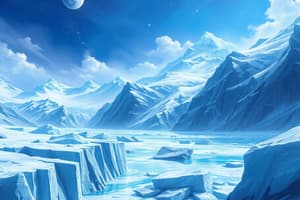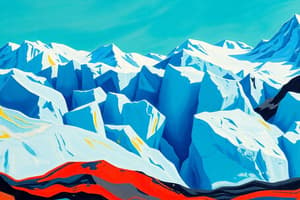Podcast
Questions and Answers
What is the cryosphere?
What is the cryosphere?
The cryosphere consists of all of Earth's frozen waters, including ice and snow in the atmosphere, lakes, rivers, oceans, on land, and under the Earth's surface.
What percentage of Earth's land surface is currently covered by glaciers?
What percentage of Earth's land surface is currently covered by glaciers?
Approximately 10%
What was the extent of glacier coverage during the Last Glacial Maximum (LGM)?
What was the extent of glacier coverage during the Last Glacial Maximum (LGM)?
Around 32% of Earth's land surface.
Which of the following are types of glaciers?
Which of the following are types of glaciers?
What percentage of the world’s glacial ice is found in Antarctica and Greenland?
What percentage of the world’s glacial ice is found in Antarctica and Greenland?
What do the Himalayas provide for the major rivers such as the Indus, Ganges, and Brahmaputra?
What do the Himalayas provide for the major rivers such as the Indus, Ganges, and Brahmaputra?
How do continental glaciers differ from alpine glaciers in terms of flow?
How do continental glaciers differ from alpine glaciers in terms of flow?
What are the effects of Quaternary glacial-interglacial cycles on landscapes?
What are the effects of Quaternary glacial-interglacial cycles on landscapes?
During warm interglacial periods, what type of weathering predominates?
During warm interglacial periods, what type of weathering predominates?
What happens to valley slopes during cold stages of glacial periods?
What happens to valley slopes during cold stages of glacial periods?
What is the molecular formula for ice?
What is the molecular formula for ice?
What is firn?
What is firn?
What process transforms snow into glacial ice?
What process transforms snow into glacial ice?
Flashcards are hidden until you start studying
Study Notes
Glacial Environment
- The cryosphere encompasses all of Earth's frozen waters, including ice, snow, and sub-surface ice.
- Glaciers form over hundreds or thousands of years above the snowline, resulting in thick ice masses.
Last Glacial Maxima (LGM)
- Currently, glaciers cover approximately 10% of Earth’s land surface, primarily in polar regions.
- During the LGM (19-20 thousand years ago), glaciers expanded to cover about 32% of the Earth's land.
Types of Glaciers
- There are two main types of glaciers:
- Continental glaciers: Vast ice sheets found in polar regions like Antarctica and Greenland, containing 99% of the world's glacial ice and about 68% of Earth's fresh water.
- Alpine glaciers (valley glaciers): Originating in mountainous areas, existing in temperate, polar, and sometimes tropical regions.
Notable Glacier Systems
- The Himalayas host the world’s third-largest glacier systems, significantly feeding major rivers such as the Indus, Ganges, and Brahmaputra.
- Continental glaciers do not flow downhill due to their extensive flat areas, while alpine glaciers flow dictated by underlying land slopes.
Quaternary Glaciation
- Quaternary glacial-interglacial cycles induce significant landscape changes, particularly at middle and high latitudes.
- Cold, dry glacial periods lead to the development of permafrost, ice sheets, and cold deserts, whereas warm interglacial phases enhance chemical weathering and soil formation.
Landscape Changes During Glacial Cycles
- During cold stages: Erosion dominates upper valley slopes; sediment supply increases in lower valleys, leading to river braiding.
- During warm stages: Erosion patterns stabilize, soil formation is encouraged, and river channels exhibit meandering and aggradation.
Pluvial and Interpluvial Phases
- In arid and semi-arid zones, variations in rainfall during pluvial (increased rainfall) and interpluvial (drier) phases cause different scales of erosion.
Ice as a Mineral
- Ice, a solid form of water (H2O), is categorized as a mineral, typically forming in hexagonal structures when water freezes.
- Glacial ice results from the transformation of snow through processes of accumulation, burial, compression, and recrystallization over varying timescales (from decades to millennia).
Studying That Suits You
Use AI to generate personalized quizzes and flashcards to suit your learning preferences.




